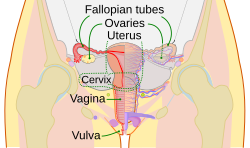Cervix
| Cervix | |
|---|---|

The human female reproductive system. The cervix is the lower narrower portion of the uterus.
|
|
| Details | |
| Precursor | Müllerian duct |
| Artery | Vaginal artery and uterine artery |
| Identifiers | |
| Latin | Cervix uteri |
| MeSH | A05.360.319.679.256 |
| TA | A09.1.03.010 |
| FMA | 17740 |
|
Anatomical terminology
[]
|
|
The cervix or cervix uteri (Latin: neck of the uterus) is the lower part of the uterus in the human female reproductive system. In a non-pregnant woman, the cervix is usually 2 to 3 cm long (~1 inch) and roughly cylindrical in shape. The narrow, central cervical canal runs along its entire length, connecting the uterine cavity and the lumen of the vagina. The opening into the uterus is called the internal os, and the opening into the vagina is called the external os. The lower part of the cervix, known as the vaginal portion of the cervix (or ectocervix), bulges into the top of the vagina. The cervix has been documented anatomically since at least the time of Hippocrates, over 2,000 years ago.
The cervical canal is a passage through which sperm must travel to fertilize an egg cell after sexual intercourse. Several methods of contraception, including cervical caps and cervical diaphragms aim to block or prevent the passage of sperm through the cervical canal. Cervical mucus is used in several methods of fertility awareness, such as the Creighton model and Billings method, due to its changes in consistency throughout the menstrual period. During vaginal childbirth, the cervix must flatten and dilate to allow the fetus to progress along the birth canal. Midwives and doctors use the extent of the dilation of the cervix to assist decision-making during childbirth.
...
Wikipedia
